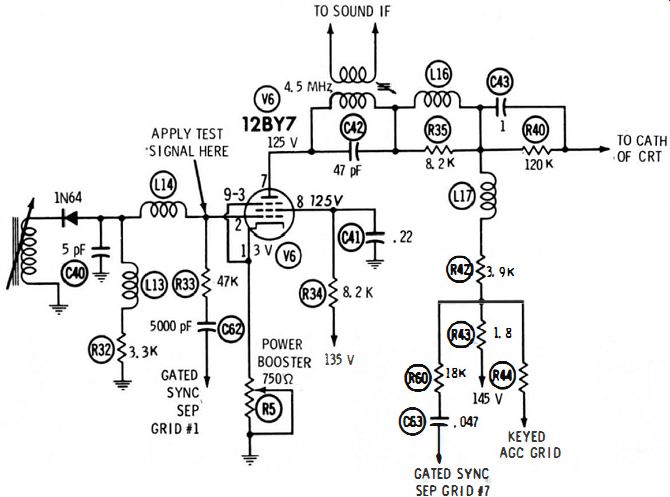A simple intercarrier sound system is diagrammed in Fig. 9-1. Some tv receivers have more stages, including a 4.5-MHz i-f amplifier preceding the limiter, and an audio driver following the sound detector. A ratio detector, or sometimes a discriminator, is used instead of a gated-beam detector. The basic signal processing occurs in all cases in this order: 4.5-MHz amplification, partial or full limiting, fm detection, and audio amplification.
The sound take-off coil (or transformer) may be connected at the video-amplifier or the picture-detector output. Sometimes the sound take-off transformer does double duty as a 4.5-MHz trap in the video amplifier. You may find an occasional receiver in which the output from the last i-f stage branches into a limiter. The 4.5-MHz signal is generated by heterodyning in the limiter instead of the picture detector. Again, you may rarely find a slope detector following the limiter. In some receivers, the audio-output stage does double duty as a B+ voltage divider.

Fig. 9-1
TEST SIGNAL FOR THE INTERCARRIER SECTION
If a modulated 4.5-MHz sound signal from an a-m generator is applied through a small blocking capacitor to the sound take- off point, you can usually signal-trace the entire sound section. Offhand, this might seem to be impossible, because the limiter stage normally rejects amplitude modulation. On the other hand, most a-m generators have appreciable incidental fm, particularly when set for high percentage modulation as illustrated in the following pages. Incidental fm makes it possible for the generator to do double duty in testing the sound section.

Fig. 9-2. Apparent a-m limiter out put, due to incidental fm. Fig. 9-3. Saturated
limiter output, no incidental fm.

Fig. 9-4. Normally tuned i-f circuits may change the waveform.
Signal-tracing in the sound section should be done with a wideband scope and a low-capacitance probe. There are two reasons: There is no a-m component in the output of a normally operating limiter (or at least negligible a-m signal), and hence a demodulator probe gives no indication when used with an ac scope. The other reason is that a demodulator probe has comparatively low input impedance, and disturbs the narrow-band fm circuits excessively.
Comparatively, a low-C probe imposes less loading and detunes the circuits less.
The scope should have good response at 4. 5-MHz. Otherwise, the signal under test will be attenuated accordingly in the scope amplifier.
If the a-m signal is found at points A and B in Fig. 9-1, the sound takeoff circuit up to the grid of the limiter is working. At point C the signal may have less apparent amplitude modulation. If the limiting action is complete, you will see a modulation envelope corresponding only to the incidental fm in the test signal (Fig. 9-2). In general, the modulation depth will be less than that of the combined a-m and fm seen at the limiter grid. If the a-m generator has no incidental fm, the output from a saturated limiter will have no modulation envelope. (Fig. 9-3).
Fig. 9-4 depicts a configuration using a sound i-f amplifier operating in class A to drive the limiter. Amplitude modulation is reproduced at points A and B, but not at point C, if the limiter is saturated. However, the waveform can appear quite different at point B than at point C when there is incidental fm in the a-m test signal. The fm component "sweeps" the sound i-f tuned circuits and adds a partial "response curve" to the a-m envelope.
This situation is illustrated in Fig. 9-5, which shows a display of the output from a fully modulated a-m generator, compared with the display after passing through a tuned class-A amplifier. The input waveform has considerable incidental fm because of 100 percent modulation. That is, the output consists of a mixture of amplitude modulation and an fm "sweep" signal. Various parts of the a-m envelope can be increased or cancelled, depending on the shape of the fm envelope. The latter varies as the generator is tuned slightly higher or lower in frequency. In Fig. 9-5, there is a cancellation as the troughs are entered, making the amplifier output appear as if the test signal were over-modulated.

Fig. 9-5. Incidental fm from modulated oscillator is maximum at 100·percent
modulation. (A) Output waveform from a-m output (B) Output waveform from i-f
generator. amplifier.
Another typical condition of incidental fm distortion is seen in Fig. 9-6. Here, a-m modulation is nearly 100 percent, and there is considerable incidental fm in the output. The amplifier output appears with a "flat-topped" envelope at one setting of the generator tuning dial. The envelope changes shape as the generator is tuned through the i-f passband, but the amplifier output never matches the generator output.

Fig. 9-6. Another example of incidental fm distortion. (A) Generator output.
(B) Amplifier output.
Incidental fm is reduced when the a-m generator is set for a comparatively low percentage modulation. This is evidence by less change in envelope shape as the generator is tuned through the sound i-f passband. A few service-type a-m generators have negligible incidental fm, and practically no change in envelope is observed as the generator is tuned through the i-f band. The generator output has the same waveform as the output from the driven class-A amplifier. The waveform of the generator output is not necessarily a sine wave. A scope test may show that a sine waveform is approached at some frequencies, or bands, but departs widely from a sine shape on other bands or at different points on the same band. The illustrations in Fig. 9-7 are typical of one service-type generator.

Fig. 9-7. Distorted outputs from an a-m generator.
It is not necessary that an a-m generator have a good waveform.
Signal-tracing can be accomplished and stage-gain measurements can be made regardless of waveform. It is only necessary to distinguish between distortion present in the generator output, and distortion which may be introduced by the sound circuits. When test work is started, it is advisable to connect the generator output cable directly to the scope's vertical-input terminals, to determine the waveform to be used at the given frequency. At this time, check also the percentage modulation. About 30-percent modulation is suitable for sound section tests. Most a-m generators have adjustable modulation depth.
The general modulating frequency is usually about 400 Hz. Thus, if the scope is deflected horizontally at a 100-Hz rate, four modulation peaks will appear in the pattern, as seen in Fig. 9-8. If the deflection rate is increased to about 300 kHz, the carrier peaks become the prominent feature in the pattern. For the types of tests described in this SECTION, the 100-Hz deflection rate is preferred.

Fig. 9-8. Effect of scope deflection rate on waveform aspect. (A) Low deflection
rate. (B) High deflection rate.
MINIMIZING CIRCUIT LOADING
As shown in Fig. 9-9, the generator output should be applied at the grid of the video-amplifier tube. If the signal is applied in the plate circuit at the actual take-off point, the 4.5-MHz transformer will be detuned. Use a small blocking capacitor in series with the "hot" lead from the generator. This avoids possible drain-off of bias voltage in a grid circuit, and possible damage to generator and receiver in a plate circuit.
Turning to the scope, a low-capacitance probe has enough input capacitance to detune many sound i-f circuits substantially. If the signal level is fairly high, you can clip the probe around the insulation of the grid or plate lead of a sound i-f tube. Otherwise, use a small trimmer capacitor for a scope probe, and reduce the capacitance to the smallest value that permits adequate deflection.

Fig. 9-9. Apply test signal at grid-not at plate.
LIMITER CHARACTERISTICS
A low-level output from the generator does not drive the limiter into saturation, and amplitude modulation is not rejected, accordingly. This condition is analogous to weak-signal reception which may be noisy because the low-level intercarrier signal is below the limiter saturation point. As a rough rule of thumb, a .I -volt 4.5-MHz signal injected at the output of the picture detector is normally expected to saturate the limiter. Proper limiter action depends on correct dc supply voltages to the limiter tube, and on good capacitors and resistors in the circuitry.
The same signal which is found at point C in Fig. 9-1 should also appear at point D. Otherwise, the sound i-f transformer is defective or misaligned. An audio-frequency signal is normally present at points E through H. If not, check the dc voltages and resistances in the associated circuit. Also, if necessary to close in on the defective component, check capacitors on a capacitor tester or by substitution.
Resistance checks can be made on coils, although this shows little aside from continuity. If a coil does not tune satisfactorily, a substitution test is preferred.
Electrolytic capacitors, if present, must be checked. Leakage or loss of capacitance can cause weak or distorted output, or both. Although numerous variations of sound-section circuitry are used in different chassis, the general principles are the same in all. It is necessary in each case to consult the receiver service data for specified voltages, resistances, and component values.
Inability of the limiter to eliminate amplitude modulation is one of the causes of sync buzz. Buzz modulation is generated in the i-f amplifier, video amplifier, or both. If the modulation depth is excessive, audible buzz will be present, regardless of limiter efficiency. It is assumed here, however, that the i-f and video amplifiers are operating properly and that only a normal amount of buzz modulation is to be contended with by the limiter.
The most severe demand is placed on the limiter stage when it is followed by a discriminator, because a discriminator has no inherent rejection of amplitude modulation. Hence, if you should be servicing a buzz complaint on a receiver of this type (they are in the minority, however), make a careful check of the limiter action. Up to 50-percent amplitude modulation should be completely "wiped off" both top and bottom of the test signal. This does require an a-m generator with very little incidental fm, because an adequate limiter stage will otherwise appear to be defective.
Less severe requirements are imposed on the limiter by a ratio detector, because this configuration inherently can reject up to 30 percent amplitude modulation if operating normally. Ratio detectors should be preceded, however, with at least partial limiting because misadjustment of the fine-tuning control or too high setting of the contrast control can otherwise lead to audible buzz and cause customer dissatisfaction. Again, if the ratio-detector alignment should drift slightly, partial limiting will assist in suppressing sync buzz. A limiter becomes more effective as the plate and screen voltages are reduced (tube saturates earlier), but the peak-to-peak voltage output is reduced accordingly. A compromise between output level and limiting action is commonly made by the manufacturer.
Signal-tracing the audio section will quickly show where the signal is stopped or substantially attenuated. The scope is the most useful instrument to find where a signal is being distorted. The most common cause of distorted sound is clipping, illustrated in Fig. 9-10.
Clipping can result from low plate or screen supply voltages, or incorrect grid (or cathode) bias. The latter commonly results from a shorted cathode bypass capacitor, or from a leaky grid-coupling capacitor. Leaky screen or decoupling capacitors can reduce the screen or plate supply voltage. Less commonly, resistors in the audio circuit increase in value and cause clipping distortion.

Fig. 9-10. Negative peak clipping of the audio signal.